Lake Mead, located between the states of Nevada and Arizona in the Southwestern United States, is a man-made reservoir formed by the Hoover Dam on the Colorado River. Considering water capacity, Lake Mead is the largest reservoir in the US. The lake is essential in providing water for Arizona, California, Nevada, and some of Mexico. Reservoirs tend to have winding paths and are challenging to measure, so how wide is Lake Mead?
How Wide Is Lake Mead?: The Maximum Width of Lake Mead
When the lake is at its highest, it measures 65 miles from Pearce Ferry to Hoover Dam and has 550 miles of shoreline. As far as width goes, from the southeast shore, where the Colorado River turns toward Hoover Dam, to the northwest shore of Las Vegas Bay, Lake Mead is 9.3 miles wide.
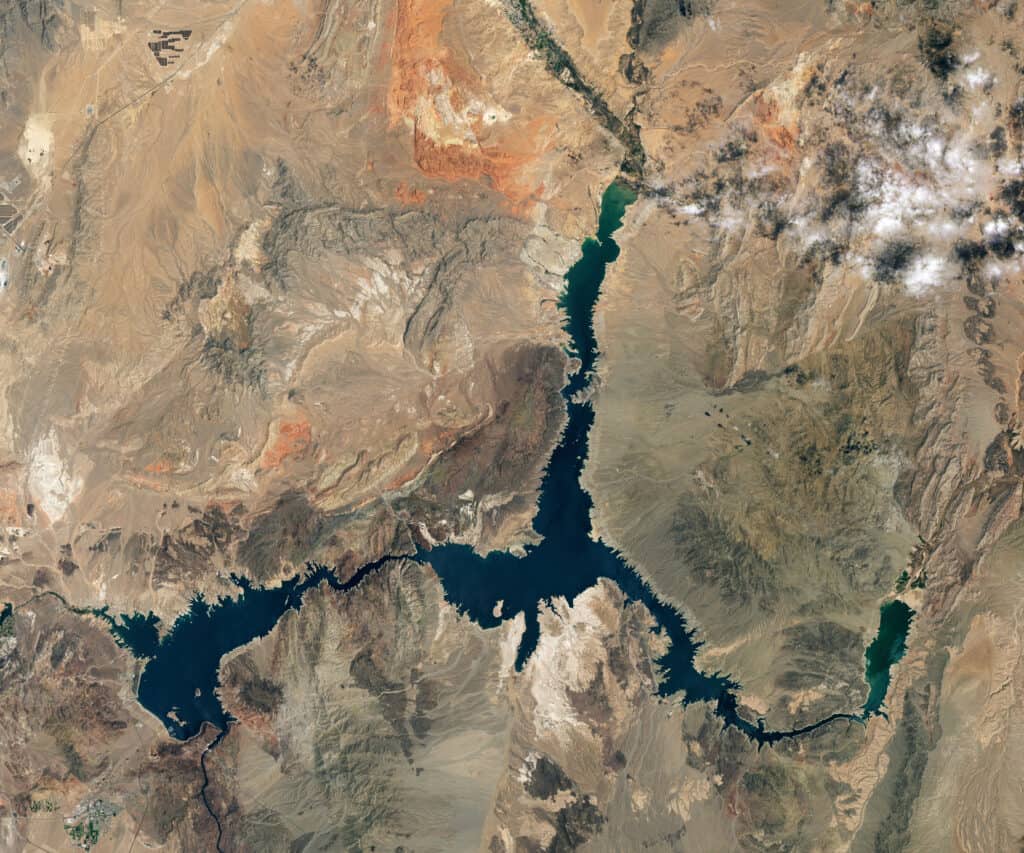
At its widest, Lake Mead is 9.3 miles across.
©NASA Earth Observatory images by Joshua Stevens, using Landsat data from the U.S. Geological Survey / Public domain, from Wikimedia Commons, the free media repository – License
How Wide Is Lake Mead?: How Long It Would Take the Average Swimmer to Swim Across Lake Mead
A swimmer would enter the water from the lake’s southeast shore, a safe distance above Hoover Dam, swim close to the southwest shore of Oberlink Island, through Boulder Basin, and toward Sand Island, which would skirt to the southeast through Las Vegas Bay. From here, they would swim directly to the northwest shore. This distance would be about 9.48 miles, taking the average swimmer four hours and forty-five minutes. There are hazards associated with swimming in Lake Mead. One should follow safety protocols and stay away from posted danger zones.
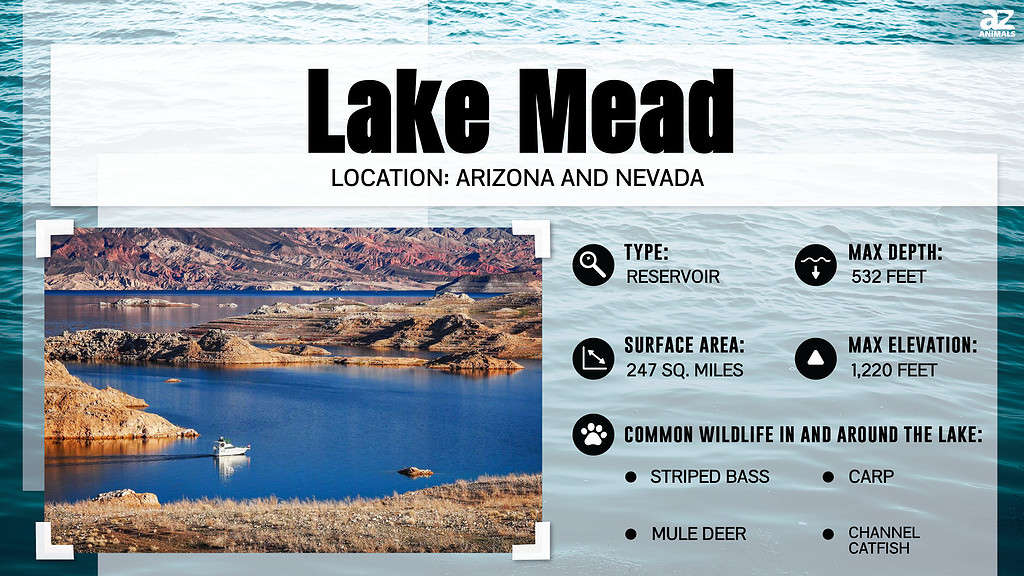
Where Is Lake Mead on a Map?
Things To Do Around Lake Mead
The area around Lake Mead is the Lake Mead National Recreation Area. This area is visited by approximately eight million residents every year. Visitors here can enjoy various recreational activities on the lake and surrounding country. Boating, canoeing, kayaking, fishing, camping, and hiking are just some activities these visitors can enjoy.
Camping
There are 15 different campgrounds within the Recreation Area, offering restrooms, running water, dump stations, and picnic amenities. Tents and trailers are welcome, and RV hookups are available within the park.
Boating
The park has launch ramps and boat rental locations for those who would like to travel the waterways and explore the bays and coves of Lake Mead. Be sure to follow all rules and park regulations while boating.
For those looking for a more personal leisurely activity, canoeing and kayaking opportunities abound on the lake. Marinas in the park offer rentals, and some companies offer guided tours.
Scuba Diving
The Recreation Area offers scuba diving for adventurers looking to gain an up close and personal experience of the lake. Lake Mead is one of the world’s top freshwater diving destinations. Options exist for novice and experienced divers with different levels and sites.
Fishing
Anglers will find that Lake Mead is an excellent destination to fish for striped bass. It’s also a great place to fish for rainbow trout, catfish, crappie, sunfish, and various bass. The rainbow trout are often released on Fridays near Willow Beach. Be aware that the lake straddles two states, each with its regulations.
Hunting
Hunting and trapping are regulated throughout the park, and the Recreation Area was set up, in part, to preserve the natural beauty and potential of the area. Check state regulations before hunting, as the states balance wildlife and habitats.
Biking
Bicycling is a great way to experience the beauty of the Lake Mead area. There are a variety of roads, routes, and trails designated and approved for bicycle use. Routes marked with numbered yellow arrow signs are designated for bicyclists.
Hiking
Most of the Lake Mead National Recreation Area is dedicated to protecting parts of the Mojave Desert. The best way to experience this is on foot. Routes take hikers through rainbow-colored rock formations and wild canyons and washes. The best time to hike is November through March, when the weather is cooler. Hiking during summer months in the day is dangerous, as temperatures can reach 120º F in the shade.
Picnicking
You don’t have to leave the park to eat, as several shaded picnic areas are there. These shaded picnic areas include tables, running water, grills, and restrooms.
Scenic Drives, Backcountry Roads, and Overlooks
There are many overlooks throughout the park and winding, scenic roads to reach these spots. A car ride will take you through canyons, desert basins, and mountains. Taking these roads can lead you to majestic panoramas of the icy blue waters of Lake Mead framed against the rainbow striations of the mountains.
Several backcountry roads also lead through the country away from the lake. These roads will take you to remote, unusual destinations and unique spots along the lakeshore. These roads are marked with yellow arrows with designated road numbers. Vehicles may not leave these roads.
Horseback Riding
Horseback riding is permitted within the park on established trails. Take care not to disturb desert ecosystems. Water is limited, and its supply should be considered for both horse and rider when planning for the day. Riders should also pick up after their horses.
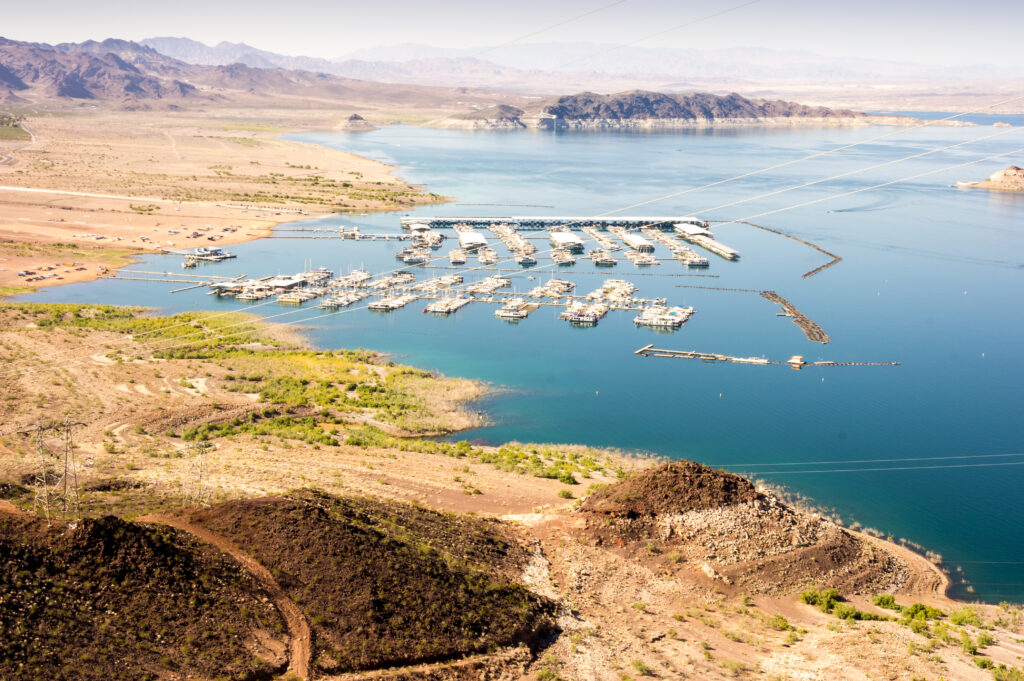
Boating from Hemenway Harbor is fun to do at Lake Mead.
©Sopotnicki/Shutterstock.com
Wildlife Around Lake Mead
Around Lake Mead, you can find mammals such as bighorn sheep, mountain lions, and bats. With such varied habitats due to the creation of lakes Mead and Mohave, it’s no surprise that the area has over 240 bird species on record, including the osprey, peregrine falcon, and burrowing owl. There are also 41 species of reptiles, including the desert tortoise, Nevada’s state reptile, and 12 species of amphibians, including the relict leopard frog. Of course, the lake includes several fish, including game fish like a variety of bass, black bullhead, crappie, green sunfish, channel catfish, tilapia, carp, and bluegill. The only native fish found in the lake is the razorback sucker.
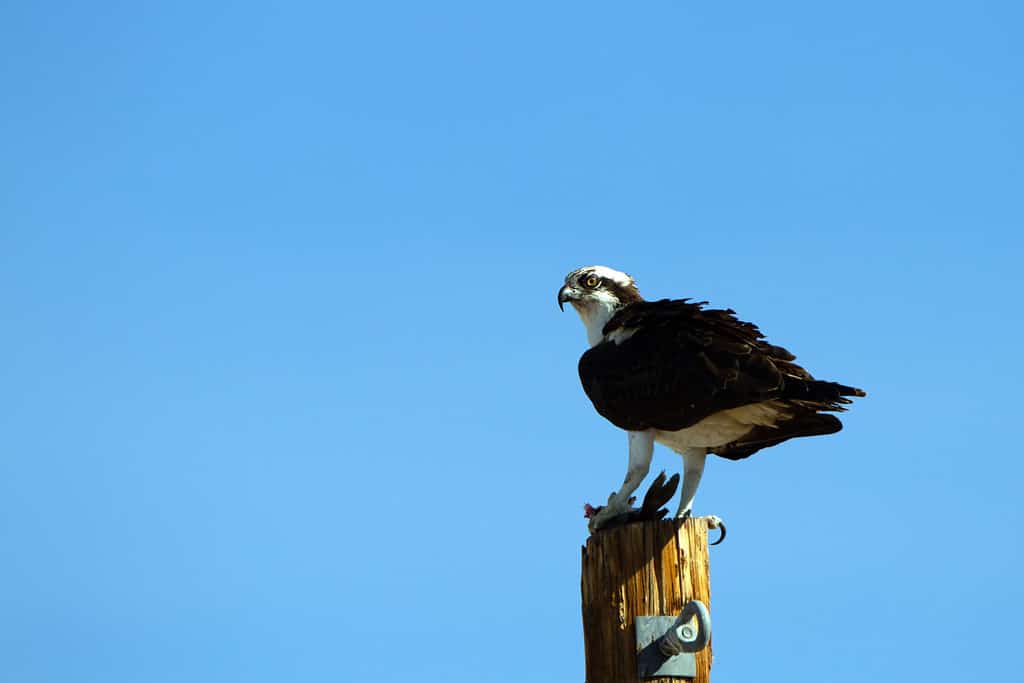
Ospreys are one of many species that live near Lake Mead.
©Martha Marks/Shutterstock.com
Comparison of Lake Mead to Other Lakes
Lake Mead provides essential functional and recreational purposes along the Colorado River. Many other lakes across the country perform similar functions.
Other Big Lakes In the Southwest United States
Several lakes in the southwest United States offer recreational amenities similar to Lake Mead.
Lake Powell
Also on the Colorado River is Lake Powell, another man-made reservoir. Situated across the border of Utah and Arizona, the reservoir snakes through valleys and canyons formed by the river, resulting in fluctuating widths. At its widest, though, the lake is about 25 miles across.
Lake Pleasant
Lake Pleasant is a beautiful lake at 1,700 feet on an Arizona mountain. The lake is an artificial reservoir with a surface area of 7,500 acres and a maximum depth of 170 feet. While it was designed to provide drinking water for the region, it is also a popular recreation destination, with activities like boating, fishing, jet skiing, and scuba diving.
Lake Tahoe
The ever-popular Lake Tahoe is The United States’ largest alpine lake. It lies on the state line between California and Nevada in the Sierra Nevada Mountains and is the second-deepest lake in the country. Lake Tahoe is among California’s most visited lakes. It has many boating, fishing, swimming, and scuba diving options.
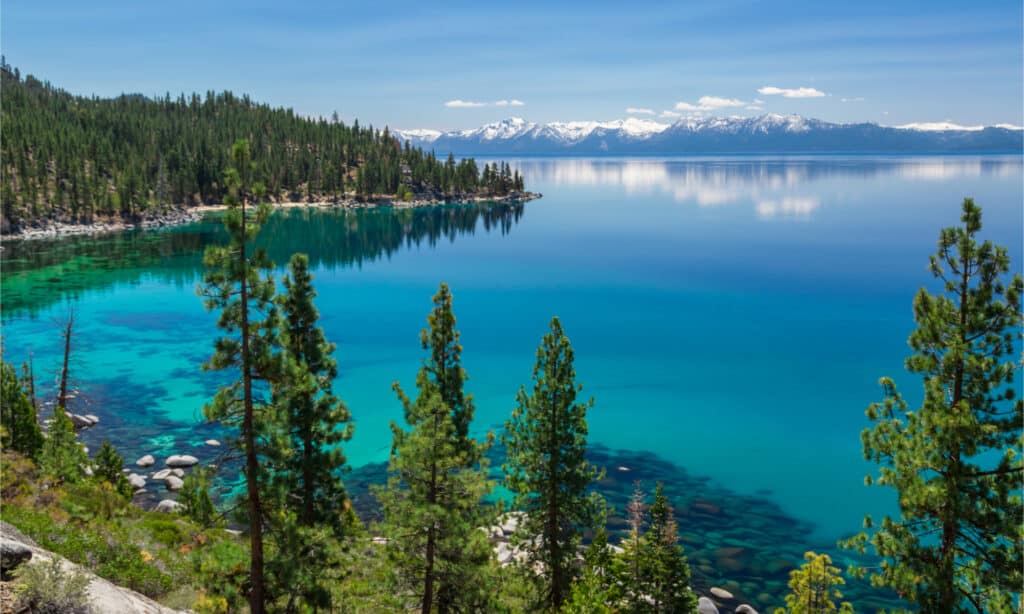
Lake Tahoe is a beautiful lake with activities similar to Lake Mead’s.
©topseller/Shutterstock.com
Other Large Lakes
Though in different geological settings, some lakes in the eastern portion of the United States also offer recreation for residents and vacationers.
Lake George
Considered the “Queen of American Lakes,” Lake George in New York is a fantastic destination for camping, hiking, fishing, swimming, and boating. There is so much to do there for vacationers and tourists. It has a surface area of 28,000 acres and over 109 miles of shoreline.
Lake Winnipesaukee
The United States’ sixth-largest natural lake has over 45,000 acres of surface area and clear waters in a pristine woodland setting. It provides opportunities for swimming, boating, and fishing. Wildlife around the lake includes black bears, beavers, otters, coyotes, mink, and moose.
Lake Champlain
Lake Champlain is a historically significant lake in New York with over 500 square miles of surface area. Not far from Lake George, the lake is between the Green Mountains of Vermont and the Adirondack Mountains. The lake is over 400 feet deep at its deepest.
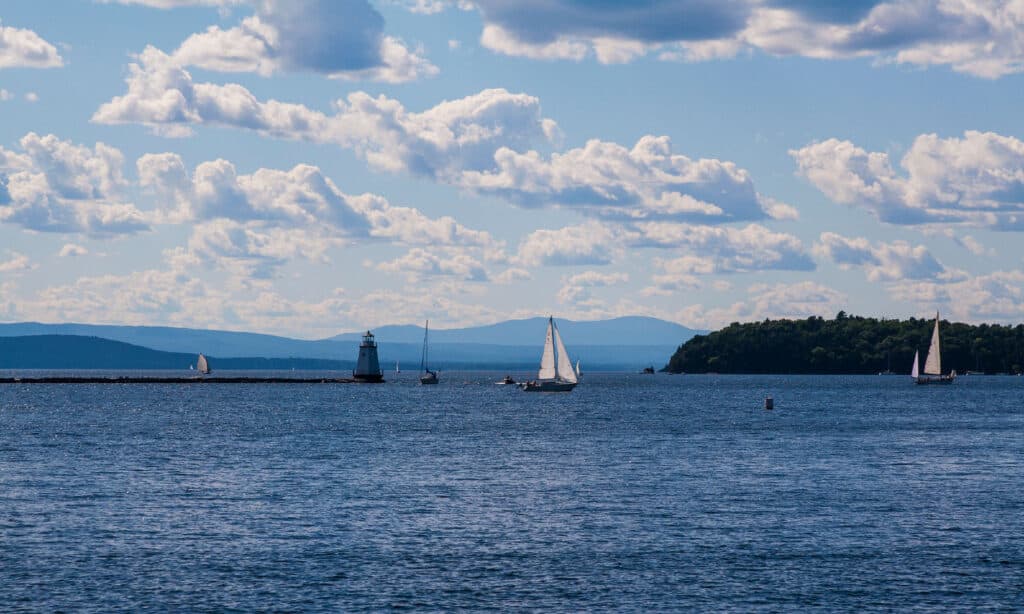
Like Lake Mead, Lake Champlain offers boating, swimming, and camping.
©Mark Castiglia/Shutterstock.com
Conclusion
Lake Mead is an integral part of the ecological picture in the US Southwest. It controls the water supply and provides recreational activities for millions every year. The lake also provides water and habitat protection for wildlife in the region. It is also a large lake, measuring 9.3 miles across at its widest point.
The photo featured at the top of this post is © iStock.com/Michael Vi
Thank you for reading! Have some feedback for us? Contact the AZ Animals editorial team.







